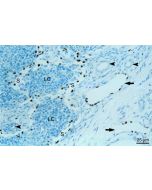Cookie Policy: This site uses cookies to improve your experience. You can find out more about our use of cookies in our Privacy Policy. By continuing to browse this site you agree to our use of cookies.
AdipoGen Life Sciences
anti-PROX1 (human), pAb

| Product Details | |
|---|---|
| Synonyms | Prox-1; Prospero Homeobox Protein 1 |
| Product Type | Polyclonal Antibody |
| Properties | |
| Source/Host | Rabbit |
| Immunogen/Antigen | Recombinant human PROX1 (aa547-737). |
| Application |
Immunohistochemistry: (frozen sections 1:750-1000) |
| Crossreactivity | Human |
| Specificity |
Recognizes human PROX1. |
| Purity | Protein A purified. |
| Purity Detail | Protein A purified. |
| Formulation | Lyophilized. |
| Reconstitution | Centrifuge vial prior to opening. Reconstitute with sterile water to a concentration of 0.1-1.0mg/ml. |
| Isotype Negative Control | |
| Other Product Data |
UniProt ID Q92786: Prox-1 (human) |
| Shipping and Handling | |
| Shipping | BLUE ICE |
| Short Term Storage | +4°C |
| Long Term Storage | -20°C |
| Handling Advice |
After opening, prepare aliquots and store at -20°C. Avoid freeze/thaw cycles. |
| Use/Stability | Stable for at least 6 months after receipt when stored at -20°C. |
| Documents | |
| MSDS |
 Download PDF Download PDF |
| Product Specification Sheet | |
| Datasheet |
 Download PDF Download PDF |
Expression of PROX1 in blood endothelial cells induces expression of other lymphatic marker genes. Together with podoplanin, PROX1 can be used to reliably distinguish lympathic vessels from blood vessels. PROX1 is expressed in CNS, eye, pancreas, liver and heart and it is one of the most specific and reliable markers for lymphatic endothelial cells. The highly conserved C-terminal part of the homeobox transcription factor PROX1 was produced in E. coli. It was not tested for activity and can be used as positive control e.g. in Western analysis.
- The Sialomucin CD34 Is a Marker of Lymphatic Endothelial Cells in Human Tumors: U. Fidler, et al.; Am. J. Pathol. 168, 1045 (2006)
- Lymphatic capillary hypoplasia in the skin of fetuses with increased nuchal translucency and Turner's syndrome: comparison with trisomies and controls: C.S. von Kaisenberg, et al.; Mol. Hum. Reprod. 16, 778 (2010)






